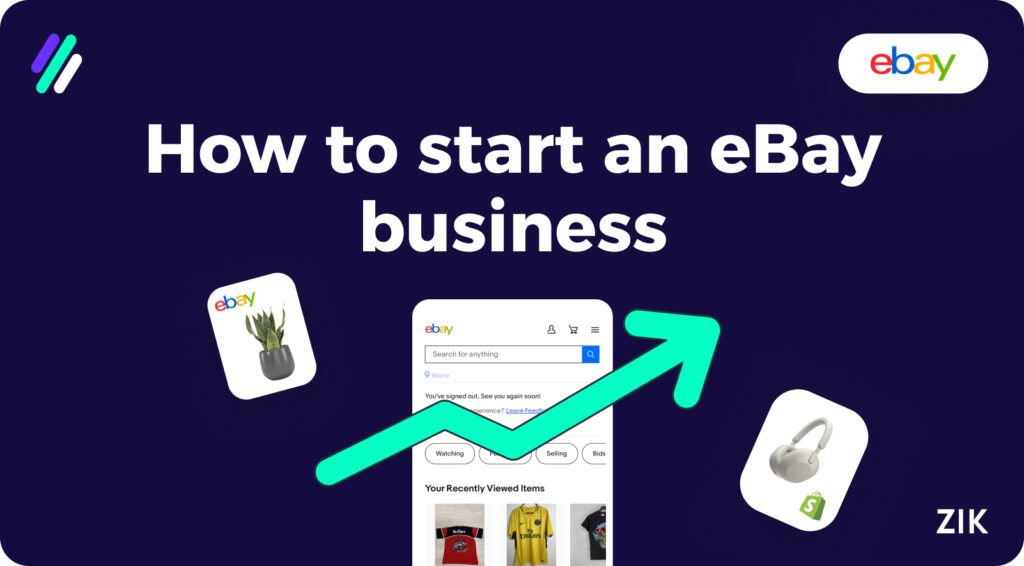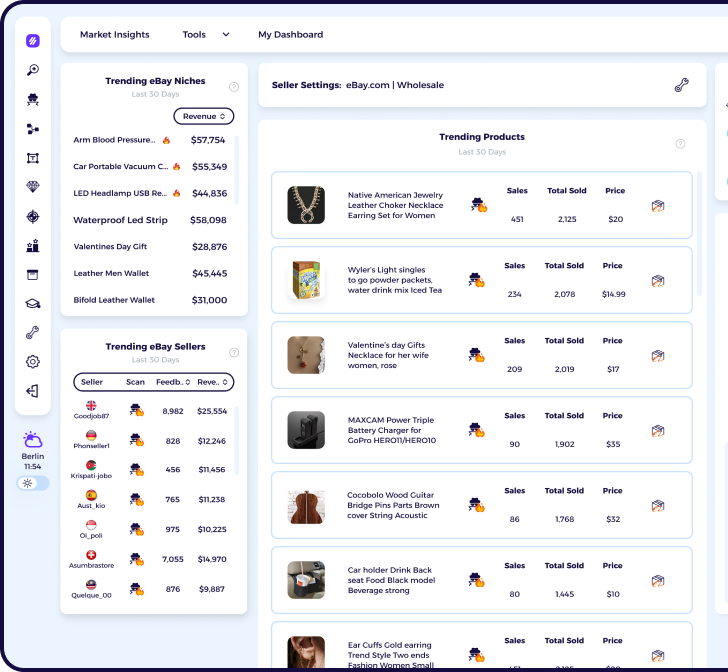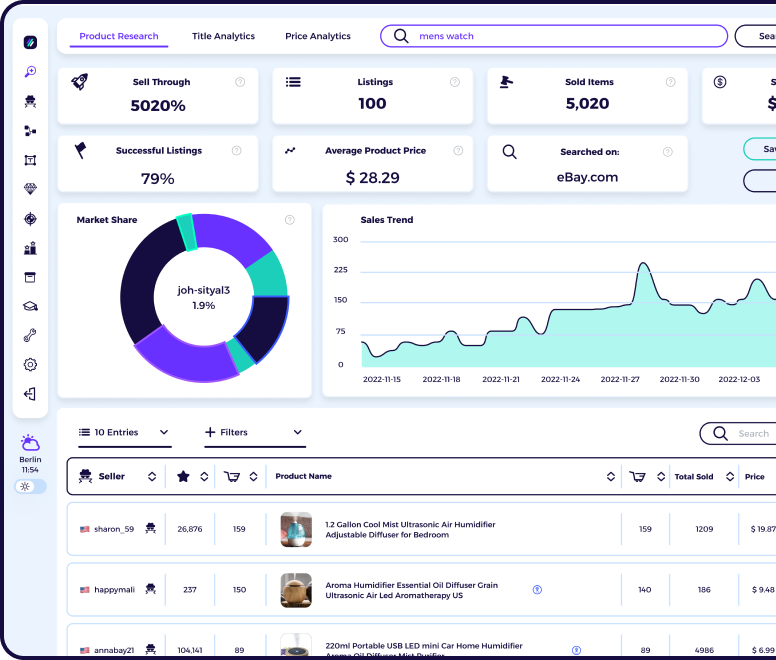As of the third quarter of the fiscal year 2023, eBay has remained solid, with its revenue growing year-on-year. With the continued supremacy of online commerce and AI tools, eBay has solidified its position among the frontrunners of online selling.
Thus, it makes sense that more sellers would want to dip their toes into setting up an eBay store in 2024 to capitalize on this growth and revenue potential. So, the first question to address is this: how to start an eBay business in 2024?
We’ve covered this extensively in our previous guide on how to sell on eBay, and we have plenty of helpful resources on the blog to help out anyone wanting to set up an eBay business. However, I created this guide as a roadmap for eBay account owners who want to take concrete steps toward realizing their vision of a business and making it into a reality.
If you’re tired of browsing various guides and articles on how to get started as an eBay seller and build a legitimate online business, this article is for you.
Article Overview:
Key Takeaways
How to Start an eBay Business in 2024
Step 1: Understand the eBay Business Policies
Step 2: Set Up an eBay Account
Step 3: Create a Business Plan
Step 4: Market Research
Step 5: Product Sourcing
Step 6: Optimizing Listings
Ready to Launch Your eBay Business in 2024?
FAQs
Key Takeaways
- Understand eBay’s policies before you launch your business.
- Market research is critical to making data-driven decisions and strategies for your eBay store.
- Competitor analysis provides insights into how well other sellers do and improves your strategy.
- Carefully vet your products and suppliers.
- Follow the best practices for product listings.
How to Start an eBay Business in 2024
This comprehensive guide makes your dreams of running a successful eBay business a reality. I have outlined the information to make it easier for you to set up your eBay store from scratch and build a strong foundation to ensure success.
Step 1: Understand the eBay Business Policies
The eBay business policies were created to guide eBay sellers and account owners on how to set up their online store. These policies serve as guidelines by which all eBay account owners must abide by when they sell on eBay, ensuring they do not violate any policies that could result in a suspension or ban.
Understanding the policies on how to sell on eBay can be overwhelming. Therefore, understanding these policies ensures your compliance as an eBay seller.
1. Prohibited and Restricted Items
eBay provides a list of prohibited and restricted items to which every seller must refer before choosing what items to add to their online store. This list is detailed and specific; and they are strictly imposed by the ecommerce platform.
No eBay seller can make ignorance of these policies as an excuse for being suspended or banned. Therefore, make it a habit to check the prohibited and restricted items list before choosing which products to sell on eBay.
Check out our guide on VeRo items on eBay here.
2. Listing Policies
Once you have picked the items to start selling on eBay, the next thing to consider as an eBay business owner is the product listings. Always review the eBay listing policies to ensure that you adhere to the existing policies.
For example, product listings must meet the following requirements:
- Must be in the correct product category
- Must contain relevant and accurate product details
- Must display high-quality product images
- Must display accurate and honest shipping times and costs
- Must be priced fairly and accurately
Effective product listings comply with eBay’s business policies and attract more potential buyers.
3. Promote a Positive Buyer Experience
Whether you want to generate positive reviews when you sell on eBay or you want to boost your seller profile, it’s essential to focus on delivering a positive customer experience. Due to the competitive nature of the ecommerce industry, giant e commerce sites like eBay puts a premium on customers.
Therefore, they reward eBay sellers who observe their business policies and focus on transparent and fair selling practices.
Step 2: Set Up an eBay Account
Taking a step toward realizing your eBay business dream in 2024 entails the most crucial step: creating your eBay account. We have a complete step-by-step guide on how to create an eBay account that you can refer to for this purpose.
First, you must go to the eBay homepage and find the “register” button at the top of the screen.

Choose between registering as an individual eBay seller or a business account. It depends on your goal when selling on eBay, so choose accordingly.
You can click the appropriate button on the registration page on eBay.

Once on the registration page, you must provide the required information to finalize the setup. You will be asked to update your payment information upon completing the account setup.
The eBay managed payments system is the primary way for eBay sellers to get paid on eBay. Therefore, you must set that up to receive payments on your account.
You can also incorporate further customizations to your eBay account, such as updating the username with your business name. However, there are additional guidelines in choosing the appropriate username, so you must keep that in mind, too.
On eBay, you can choose from various eBay store subscription levels that determine the amount of products you can list on your store. The more product listings are available, the higher the cost of the store subscription.
But if you’re serious about making money with eBay in 2024, I recommend you consider the more advanced store subscription levels to save on the listing fee, as you have more free listings in your eBay shop. And the more products you can list, the higher the chances of selling on eBay!
Step 3: Create a Business Plan
Any business, including an eBay business, requires extensive planning. It is essential to your success, especially with many other sellers trying to sell the same products as you!
A business plan is vital in laying the groundwork for your online store and business. Here is what you need to create an effective business plan before you start selling on eBay:
- Executive Summary – The executive summary provides a mission statement defining your eBay business’s purpose. It will also provide an overview of the business concept and steps on how to start an eBay business.
- Business Description – This section is where you will dive into more details about the specifics of your eBay business. Discuss the specific niche or target audience you want to target for the business. Also, point out the market trends and why there is a demand for your chosen niche.
- SWOT Analysis – Assess your business idea’s strengths, weaknesses, opportunities, and threats.
- Product & Services – Identify what products you want to sell on eBay and how to source those products.
- Business Model – Identify the business model you will use for your ecommerce business and pricing strategy.
- Marketing and Sales – Outline the marketing channels you will employ to grow your online store and the sales strategy to boost profits. Identify what will distinguish you from other sellers and how to attract potential buyers.
- Operations – Provide a detailed plan for managing the operational aspects of running the eBay business, such as inventory management and order fulfilment.
- Finances – Identify where and how you will generate the funds to invest in your e-commerce business. Break down your operational expenses and pinpoint your ideal profit margin.
Step 4: Market Research
Armed with information from your well-thought-out business plan, you can take the next step on how to start an eBay business in 2024. Conducting market research using a market and product research tool, such as ZIK Analytics, is crucial.
This tool is what separates casual sellers from successful eBay sellers. It shows that you’re invested in growing your eBay store and making a profit that will sustain the business.
You need market research for several reasons when starting an eBay store.
1. Identify a Niche
Market research enables you to identify the best-selling niche on eBay. Most eBay sellers would choose to sell products based on their interests and expertise.
While this is a good option to launch your eBay store, it might not be the most lucrative route. I recommend using tools like ZIK Analytics to provide objective, data-based research about the best-selling niche.
When I log into the ZIK Analytics dashboard, I can see eBay’s top trending niches. This data is constantly changing and updating based on the actual sales data on eBay.


Therefore, you can eliminate personal biases when determining what products to sell on eBay. You can use this information objectively based on what item sells on the platform and how many other eBay sellers have earned money!
So, why is it important to know eBay’s top trending niches and products? It’s simple. It guides you to what the customers want, and you can leverage that demand to attract potential buyers to your eBay store.
You can get a slice of the pie by knowing a demand for a particular product or niche. You know customers want it, so be sure to offer it to them!
One thing that I would suggest when using market research tools to identify the best products to sell on eBay is to incorporate a mix of trending and evergreen products. Staying on top of the latest and emerging market trends is crucial.
However, you should also incorporate evergreen products into your eBay store to ensure consistent sales throughout the year instead of focusing entirely on seasonal and trendy products.
Another advantage of using market research tools and analyzing data to inform you of the best products to sell is the opportunity to explore unique offerings.
If you focus solely on products or niches you are familiar with, you limit your store’s potential to grow and expand. Use the available data to tap into underserved customer segments and carve your niche.
2 Competitor Analysis
Another nifty feature that I love about market research tools is that it lets you get a peak into what your competitors are doing. Competitor analysis is necessary if you want to know when starting an eBay business.
Product and market research tools like ZIK Analytics provide many opportunities to analyze how well your competition is doing.

First, market research shows you who your top competitions are, and gain insight into what products they are selling (especially those that are doing well). You can assess their top selling items to know what appeals to your target customer base.
Using this approach informs your own marketing strategy for your eBay store.
Second, it helps evaluate your product range. Looking at your competition’s best-selling items and how they market them to their customers will inform your selling strategy.
What are the potential weaknesses in their strategy? Is there anything that you can capitalize on that will help outdo the competition?
Third, you can also use competitor analysis from market research to analyze the competition’s pricing strategy. For many buyers, price is a crucial determiner of where they will buy, especially if they find similar products sold on eBay.
Therefore, you can leverage your pricing strategy to attract more potential buyers. No, it does not mean you have to low-ball your product prices to attract more buyers. Instead, focus on providing value and making your product listings more attractive to other eBay sellers.
One example that I would recommend is to fine-tune your product listings. Use high quality images on your product listings to give more credibility to your eBay store.
Include accurate and well-written product details and descriptions to help your customers find the information they need to finalize their purchase decision. Focus on the smaller details that other sellers, or your competition, might miss.
Therefore, market research and competitor analysis are highly important because you can highlight the unique value proposition of your business.
3. Assess Profitability and Demand
The final reason why conducting market research is vital when you want to know how to start an eBay business is to assess the demand and profitability of the products. Market research tools, like ZIK Analytics, provide detailed information and sales data, such as the following:
- Sell through rate
- Successful listings rate
- Average sales price
- Active listings
- Sold items
- Sales earnings

You can also get information on the sales trend with a graph, so you can visually represent how well a particular product or niche has performed over a certain period. Therefore, you are not blindly adding items to your eBay store.
The data is provided to help you make informed decisions about whether certain products are viable.
Aside from actual sales data, you can get helpful information like search volume and sales price. These factors are vital in assessing profitability and potential market demand (whether seasonal or not).
You can adapt your market strategy based on these trends and data, giving you more confidence when you set up your eBay store.
Step 5: Product Sourcing
Product sourcing is another vital step to starting an eBay business that is linked with market research. When doing market research, you should consider where you are getting your suppliers.
The products you will sell on eBay will be the core of your business; therefore, you should consider closely where you get those products.
The first decision is whether to sell new or brand-new items. Since eBay is unique from other e commerce sites as it allows the sale of used items, you can weigh the pros and cons of selling used or new items.
The next step is to identify sourcing channels if you decide to sell brand-new items on eBay. Suppliers and manufacturers are the primary sourcing channel for your products.
You can go directly to the manufacturers if you want the highest quality assurance for your products. But where can you find these suppliers and manufacturers?
One option would be visiting trade shows and networking with potential manufacturers and suppliers. Or, you can contact them directly, expressing your interest in selling their products on your eBay store.
If the first option isn’t possible, I suggest you look into wholesale suppliers. These sellers specializing in providing bulk quantities of certain products for a discounted price.
Wholesale suppliers act as intermediaries between manufacturers and retailers. Thus, you can find wholesalers for diverse products in different categories.
If you are using the dropshipping business model, you can also find potential dropshipping suppliers online. ZIK Analytics stand out from other market research tools because you can use it to find potential suppliers for your eBay store.

It streamlines the selling process on eBay because you can find suppliers directly from the platform, especially for similar products your competitors are selling or are trending on eBay. Thus, you can save time finding products and suppliers, whether from Aliexpress, Amazon, or elsewhere.
I have a few tips when choosing your suppliers for your eBay business if you want to ensure the best items sell:
- Evaluate the supplier reliability. Check the supplier’s seller rating and track record before ordering bulk items.
- Ask for product samples (if possible). It is crucial to help assess product quality, especially overseas ones.
- Negotiate prices and payment terms. Take advantage of discounts offering more savings and a higher profit margin.
- Diversify your suppliers. Do not rely on a single supplier to avoid disruptions to your business if the initial supplier suffers from shipment delays and other issues.
Step 6: Optimizing Listings
Your product listings are another crucial aspect of your eBay business. The product listings are what the potential buyers will see that will help them decide if they want to purchase a product or not. Therefore, you must put your best foot forward to make more sales.
I have covered the best tips and practices for optimizing your eBay product listings, but I will cover the basic essentials here.
1. Keyword Research
Keyword research will be the backbone of your product listing optimization. The keywords are what potential buyers use to find the products they want to buy on eBay.
Therefore, you must target those keywords to bring them to your listing page.
Focus on keywords with a high search volume and low competition. Target a mix of short- and long-tail keywords.
2. Optimize the Listing Title
The listing title is the first thing buyers will see before clicking on your listing. Therefore, make it count.
Optimize the product listing title with the right keywords. However, make it attractive enough for human buyers to ensure it piques their interest.
Thankfully, ZIK Analytics has a Title Builder feature that you can use to simplify the process of building titles for your products.

3. Add the Correct Product Category
Listing the product in the correct category is crucial. Many eBay buyers would narrow their search for a product based on category.
Therefore, listing your product in the correct category gives you the advantage of being found on eBay.
4. Optimize the Product Description
The listing description is where you will dive into the product details. Therefore, make it useful and provide adequate information about the product that buyers want to know about before buying it.
It’s crucial to emphasize that the product details must be relevant and accurate. Do not add details that entice buyers to purchase a product when it isn’t true.
Deceptive listings can hurt your chances of making a sale and could even get you penalized by eBay!
5. Add High Quality Images
Adding high quality photos to your listing is crucial as it allows buyers to visualize the product. I wouldn’t want to buy a product I haven’t seen!
Therefore, the same goes for your buyers.
Include as many photos as allowed in the eBay listing, ensuring you provide an image of the product from every angle. Listings with photos sell better than those without or only have a few photos.
6. Pricing
Developing a competitive pricing strategy can make or break your eBay business. Aim for a solid profit margin while keeping your pricing competitive.
You can use an eBay profit calculator to determine how much to sell certain products in your store.
Ready to Launch Your eBay Business in 2024?
There you have it, the ultimate guide on how to start an eBay business in 2024! There’s a ton of information here but focus on one step at a time to help lay out a strong foundation for a successful business.
I cannot guarantee that you will become successful with this strategy. However, you are one step closer to success if you devise a well-crafted plan and use reliable tools that give you valuable insight into the market and trends.
FAQs
How much does it cost to start selling on eBay?
It depends on whether you purchase an eBay store subscription. However, standard fees are involved when selling, such as the final value fees and listing fees.
Is selling on eBay worth it?
Yes. The e-commerce industry is growing, and eBay is among the top-selling platforms online. However, your success depends on several factors, such as product sourcing, competition, and market trends.
What license do I need to sell on eBay?
Depending on where you are selling from, the type of business license required to sell on eBay may vary significantly.






